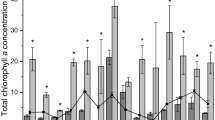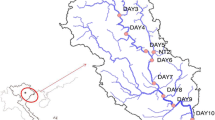Abstract
The variations of phytoplankton functional groups and their correlation with environmental factors, as well as the applicability of phytoplankton functional groups to serve as biological water quality indicator in the Pearl River, South China, were studied in the present study. A total of 96 samples were collected and divided into 21 functional groups from September 2016 to July 2017. The phytoplankton functional groups P and G were dominant during the investigation, and their biomass contributing was ranged 0.06 to 89.07%, the average 30.73%, and ranged 1.47 to 62.40%, the average 9.33% of the total biomass, respectively. The results showed environmental estrogens—BPA (bisphenol A), E2 (17β-estradiol), E1 (estrone), 4-t-OP (4-tert-octylphenol), 4-NP (nonylphenol), TCS (triclosan), and TCC (triclocarban)—in the Pearl River were significantly different, and with average values of 269.30 ng L−1, 2.76 ng L−1, 4.24 ng L−1, 53.68 ng L−1, 952.72 ng L−1, 16.79 ng L−1, and 8.61 ng L−1, respectively. This was likely responsible for the differences in the phytoplankton functional groups. We observed positive correlations between P and A, and G and J. Functional groups P biomass decreased significantly with functional groups LM increased, and functional groups M and J with X2. We found positive correlations between functional group G and concentrations of E1 and TCC; functional group A and total nitrogen (TN), 4-NP, 4-t-OP, and E2; functional groups LM and L1 and total suspended particles, BPA, and TCS; and functional group G and negative total phosphorus (TP), pH, and TCS. The study showed that TN, TP, and the environmental estrogens in the aquatic ecosystems were correlation with phytoplankton functional groups type, and affected the ecological balance in aquatic environments.






Similar content being viewed by others
References
Abonyi A, Leitão M, Lançon AM, Padisak J (2012) Phytoplankton functional groups as indicators of human impacts along the River Loire (France)[J]. Hydrobiologia 698(1):233–249. https://doi.org/10.1007/s10750-012-1130-0
Basu BK, Pick FR (1995) Longitudinal and seasonal development of planktonic chlorophyaa a in the Rideau River, Ontario [J]. Can J Fish Aquat Sci 52:804–815
Brett MT (1993) Comment on “possibility of N or Plimitation for planktonic cladocerans: an experimental test” (Urabe and Watanabe) and “Nurrient elemental limitation of zooplankton production” (Hessen)[J]. Limnol Oceanogr 38:1333–1337. https://doi.org/10.4319/lo.1993.38.6.1333
Chen C, Li S-J, Hu R, Han B-P (2013) Comparative analysis of four methods for calculating biomass of phytoplankton community[J]. JLake Sci 25(6):927–935 https://doi.org/CNKI:SUN:FLKX.0.2013-06-017
Cheung K-C, Poon B-H-T, Lan C-Y, Wong M-H (2003) Assessment of metal and nutrient concentrations in river water and sediment collected from the cities in the Pearl River Delta[J] South China. Chemosphere 52:1431–1340. https://doi.org/10.1016/S0045-6535(03)00479-X
Crossetti LO, Bicudo CEM (2008) Phytoplankton as a monitoring tool in a tropical urban shallow reservoir (Garças pond): the assemblage index application[J]. Hydrobiologia 610:161–173. https://doi.org/10.1007/s10750-008-9431-z
Çelik K, Sevindik TO (2015) The phytoplankton functional group concept provides a reliable basis for ecological status estimation in the Çaygören Reservoir (Turkey) [J]. Doga, Turkish Journal of Botany 39(4):1226–1230
Çelekli A, Öztürk B (2014) Determination of ecological status and ecological preferences of phytoplankton using multivariate approach in a Mediterranean reservoir[J]. Hydrobiologia 740:115–135. https://doi.org/10.1007/s10750-014-1948-8
Cellamare M, Morin S, Coste M, Haury J (2012) Ecological assessment of French Atlantic lakes based on phytoplankton, phytobenthos and macrophytes[J]. Environ Monit Assess 184:4685–4708
Dai J, Wang C, Lai Z-N, Li X-H, Luo J-R (2007) Net phytoplankton community of the five Pearl River opening in the summer of 2006[J]. Freshw Fish 37(3):63–66
De Pauw N, Pruder G (1986) Use and production as food in aquaculture: practice, problems and research needs. In: Bilio M, Rosenthal H, Sindermann CJ (eds) Realism in aquacultues: achievements, constraints, prespectives. European Aquaculture Society, Bredene, pp 77–106
Fan JJ, Wang S, Tang JP, Zhao JL, Wang L, Long SX (2019) Bioaccumulation of endocrine disrupting compounds in fish with different feeding habits along the largest subtropical river, China. Environ Pollut 247(2019):999–1008. https://doi.org/10.1016/j.envpol.2019.01.113
Feng J-P, Jiang S, Qiao Y-M, Li W-X, Guan X, Feng J-H (2012) Study on characteristics of phytoplankton community in Guangzhou segment of the Pearl River Estuary[J]. Ecol Sci 31(3):284–288. https://doi.org/10.1007/s11783-011-0280-z
Gao Y, Lai Z-N, Zeng Y-Y, Yan W-L, Wang C, Liu Q-F (2015) Community structure of copepods and the relationship with aquatic environmental factors in the Pearl River Delta [J]. JFSC, Journal of Fishery Sciences of China 22(2):302–310
Ha K (1999) Phytoplankton community dynamics and microcystis bloom development in a Hypertrophic River (Nakdong River, Korea)[M].Ph.D. dissertation. Pusan National University, Pusan, pp140
Hader DP (1988) Ecological consequences of photomovement in micro-organisms[J]. Hydrobiologia. 470:235–245
Harris GP, Smith REH (1977) Observations of small-scale spatial patterns in phytoplankton populations[J]. Limnol Oceanogr 22:887–890. https://doi.org/10.4319/lo.1977.22.5.0887
He B-Y, Dai M-H, Zhai W-D, Wang L-F, Wang K-J, Chen J-H et al (2010) Distribution, degradation and dynamics of dissolved organic carbon and its major compound classes in the Pearl River estuary, China[J]. Mar Chem 119:52–64. https://doi.org/10.1016/j.marchem.2009.12.006
Hirooka T, Nagase H, Uchida K, Hiroshige Y, Ehara Y, Nishikawa J, Nishihara T, Miyamoto K, Hirata Z (2005) Biodegradation of bisphenol A and disappearance of its estrogenic activity by the green alga Chlorella fusca var. vacuolata[J]. Environ Toxicol Chem 24(8):1896–1901. https://doi.org/10.1897/04-259r.1
Hu H-J, Li Y, Wei H, Zhu J (1980) Freshwater algae in China. Shanghai Science and Technology Press, Shanghai
Huang G-J, Li Q-H, Wang X-Q, Han M-S, Li L, Xiao J, Liu Y-P (2018) Responses of phytoplankton functional groups to environmental factors in the Maixi River, southwest China[J]. J. Limnol 77(1):88–99. https://doi.org/10.4081/jlimnol.2017.1613
Jiang M, Peng Z-R, An S-J, Cai Y-Y, Xue L (2006) Toxic effects of 4-nonylphenol on three aquatic organisms [J]. AHS, Acta Hydrobiologica Sinica 30(4):489–492
Kruk C, Mazzeo N, Lacerot G, Reynolds CS (2002) Classification schemes for phytoplankton:a local validation of a functional approach to the analysis of species temporalreplacement. J Plankton Res 24:901–912. https://doi.org/10.1093/plankt/24.9.901
Lei G-Y, Yang Y-F, Wang Q, Hu R, Wang Z-H (2007) Characteristics of water quality and phytoplankton community in the Guangzhou segment of the Peal River [J]. Journal of Jinan University (Natural science) 28(3):302–307
Li Y-S, Yong P (2001) Hydrodynamic model for river network in Pearl River Delta[J]. J Hydrodyn 16(2):143–155
Li R, Liu Y, Tan F-Y (2006) Bioaccumulation and biodegradation of bisphenol A by cyclotella caspia[J]. Acta Sci Circum Stantiae 26(7):1101–1106. https://doi.org/10.1016/S1872-2040(06)60041-8
Liu K-R (2008) The tendency of biodiversity variation of phytoplankton in Pearl River Estuary. Dalian Maritime University master’s thesis
Long S-X, Hamilton P-B, Yang Y, Ma J-R et al (2018) Multi-year succession of cyanobacteria blooms in a highland eutrophic reservoir Guizhou Province, China. J Limnol 77(2):44–58
Long SX, Hamilton PB, Henri JD et al (2019) Effect of algal and bacterial diet on metal bioaccumulation in zooplankton from the Pearl River, South China[J]. Sci Total Environ 675(2019):151–164. https://doi.org/10.1016/j.scitotenv.2019.04.141
Lu F-H, Ni H-G, Liu F, Zeng E-Y (2009) Occurrence of nutrients in riverine runoff of the Pearl River Delta, South China[J]. J Hydrol 376:107–115. https://doi.org/10.1016/j.jhydrol.2009.07.018
Lund JWG, Mackereth FJH, Mortimer CH (1963) Changes in depth and time of certain chemical and physical conditions and of the standing crop of Asterionellaformosa Hass. In the north basin of Windermere in 1947 [J]. Philos Trans R So Lond B 246(731):255–290
Ma J-R, Bq Q, Paerl HW, Brookes JD, Wu P, Zhou J, Deng J-M, Guo J-S, Li Z (2015) Green algal over cyanobacterial dominance promote with nitrogen and phosphorus additions in a mesocosm study at Lake Taihu, China[J]. Environ Sci Pollut Res 22(7):5041–5049
Mai B-X, Fu J-M, Zhang G, Lin Z, Min Y-S, Sheng G-Y et al (2001) Polycyclic aromatic hydrocarbons in sediments from the Pearl river and estuary, China: spatial and temporal distribution and sources[J]. Appl Geochem 16:1429–1445. https://doi.org/10.1016/S0883-2927(01)00050-6
Muller-Navarra D, Brett MT, Liston AM et al (2000) A highly unsaturated fatty acid predicts carbon transfer between primary producers and consumers[J]. Nature 403(6):4–77. https://doi.org/10.1038/47469
Nakajima N, Teramoto T, Kasai F et al (2007) Glycosylation of bisphenol a by freshwater microalgae [J]. Chemosphere 69(6):934–941. https://doi.org/10.1016/j.chemosphere.2007.05.088
Nixon S (1995) Coast marine eutrophication: a definition, social causes and future concerns [J]. Ophelia 41:199–219. https://doi.org/10.1080/00785236.1995.10422044
Padisák J, Crossetti L, Naselli-Flores L (2009) Use and misuse in the application of the phytoplankton functional classification: A critical review with updates. Hydrobiologia 621:1–19. https://doi.org/10.1007/s10750-008-9645-0
Pan K, Wang W-X (2012) Trace metal contamination in estuarine and coastal environments in China[J]. Sci Total Environ 421:3–16. https://doi.org/10.1016/j.scitotenv.2011.03.013
Pápista É, Ács É, Böddi B (2002) Chlorophyll-a determination with ethanol — a critical test. Hydrobiologia 485:191–198. https://doi.org/10.1023/A:1021329602685
Redfield A-C (1958) The biological control of chemical factors in environment [J]. Am Sci 46:205–222
Reynolds CS (1984) The ecology of freshwater phytoplankton [M]. Cambridge university press
Reynolds CS, Descy JP, Padisak J (1994) Are phytoplankton dynamics in rivers so different from those in shallow lakes [J]. Hydrobiologia. 289(1):1–7. https://doi.org/10.1007/BF00007404
Reynolds CS, Huszar VLM, Kruk C, Naselli-Flores L, Melo S (2002) Towards a functional classification of the freshwater phytoplankton[J]. J Plankton Res 24:417–428. https://doi.org/10.1093/plankt/24.5.417
Salmaso N, Naselli-Flores L, Padisák J (2015) Functional classifications and their application in phytoplankton ecology[J]. Freshw Biol 60(4):603–619
Sommer U, Gliwiczz M, Lampert W et al (1986) The PEG-model of seasonal succession of planktonic events in fresh waters[J]. Arch of Hydrobiol 106(4):433–471
Tao Y-Q, Xue B, Lei G-L, Liu F, Wang Z (2017) Effects of climate change on bioaccumulation and biomagnification of polycyclic aromatic hydrocarbons in the planktonic food web of a subtropica shallow eutrophic lake in China. Environ Pollut 223(2017):624–634. https://doi.org/10.1016/j.envpol.2017.01.068
Vanni M, Temte T (1990) Seasomal patterns of grazing and nutrient limitation of phytoplankton in a eutrophic lake[J]. Limol Oceanogr 35:697–709. https://doi.org/10.4319/lo.1990.35.3.0697
Wang S-J, Lin C, Cao X-Z (2011) Heavy metals content and distribution in the surface sediments of the Guangzhou section of the Pearl River, Southern China[J]. Environ Earth Sci 64:1593–1605. https://doi.org/10.1007/s12665-011-1172-z
Xiao L, Wang T, Hu B, Wang S, Qian X, Padisak J (2011) Succession of phytoplankton functional groups regulated by monsoonal hydrology in large canyon-shaped reservoir. Water Res 45:5009–5019
Yang Y-Q, Liu Z-L, Chen F-R, Wu S-J, Zhang L, Kang M-L, Li J (2014) Assessment of trace element contamination in sediment cores from the Pearl River and estuary, South China: geochemical and multivariate analysis approaches[J]. Environ Monit Assess 186:8089–8107. https://doi.org/10.1007/s10661-014-3989-x
Yoshiyama K, Nakajima H (2002) Catastrophic transition in vertical distributions of phytoplankton: alternative equibibria in a water column [J]. J Theor Bio 216:397–408
You J-T (2006) The composition of seston fatty acids and structure of phytoplankton communities in tropical and subtropical lakes and reservoirs[D]. JiNan University doctoral thesis
Zhang J-Y, Jiang J-L, Liu Q, Gong Y-X, Wang Q, Yang Y-F (2011) The characteristics of microbial and phytoplankton community and water quality in the Guangzhou Segment of Pearl River[J]. J Hydroecol 32(2):38–46
Zhang X, Huang X-P, Shi Z, Ye F, Liu Q-X (2013) Spatial and temporal variation of picophytoplankton in the Pearl River Estuary[J]. Acta Ecol Sin 33(7):2200–2211
Zhen G-C, Li Y, Tong Y-D, Yang L, Zhu Y, Zhang W (2016) Temporal variation and regional transfer of heavy metals in the Pearl River, China[J]. Environ Sci Pollut Res 23:8410–8420. https://doi.org/10.1007/s11356-016-6077-7
Funding
This work was supported by the Program for First-class Discipline Construction in Guizhou Province (201785), and the National Top Discipline Construction Project of Guizhou Province: Geography in Guizhou Normal University (85 2017 Qianjiao Keyan Fa). Additional support came from the Special Funding of Guiyang Science and Technology Bureau and Guiyang University (GYU-KYZ-2019). Financial support was provided by the Discipline and Master’s Site Construction Project of Guiyang University by Guiyang City Financial Support Guiyang University (SH-2020). The Project of Innovation Program for Postgraduate Education of Guizhou Province: Xiong Kangning’s studio of postgraduate supervisors for the karst environment of Guizhou Province (04 2016 Qianjiao Yanhe GZS ZI), and the National Science Foundation of China-Guangdong United Foundation (U1501235).
Author information
Authors and Affiliations
Corresponding authors
Additional information
Responsible editor: Philippe Garrigues
Publisher’s note
Springer Nature remains neutral with regard to jurisdictional claims in published maps and institutional affiliations.
Shengxing Long and Ting Zhang contributed to the work equally and should be regarded as co-first authors.
Electronic supplementary material
ESM 1
(DOCX 44 kb)
Rights and permissions
About this article
Cite this article
Long, S., Zhang, T., Fan, J. et al. Responses of phytoplankton functional groups to environmental factors in the Pearl River, South China. Environ Sci Pollut Res 27, 42242–42253 (2020). https://doi.org/10.1007/s11356-020-08344-9
Received:
Accepted:
Published:
Issue Date:
DOI: https://doi.org/10.1007/s11356-020-08344-9




